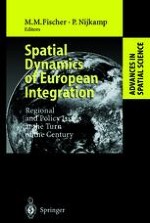1999 | OriginalPaper | Buchkapitel
The Central and Eastern European Union Enlargement and the EMU: Nominal Convergence and the Optimum Currency Areas Approach
verfasst von : Joan Costa Font, Joan Batalla Bejerano
Erschienen in: Spatial Dynamics of European Integration
Verlag: Springer Berlin Heidelberg
Enthalten in: Professional Book Archive
Aktivieren Sie unsere intelligente Suche, um passende Fachinhalte oder Patente zu finden.
Wählen Sie Textabschnitte aus um mit Künstlicher Intelligenz passenden Patente zu finden. powered by
Markieren Sie Textabschnitte, um KI-gestützt weitere passende Inhalte zu finden. powered by
Until recently, one of the main shortcomings of the structure of the EU was the existence of a frontier between Eastern and Western Europe. However, in the period 1994–1996 ten Central and East European Countries (CEECs) applied for EU membership, signing European association agreements as a first step in the integration process. The outcome was the European Commission’s decision in 1997 to begin negotiations in order to expand the EU to the east. This is the fifth EU enlargement, but it introduces new issues regarding economic integration and nominal convergence. The strategy adopted in the Amsterdam Treaty (1996) and Luxembourg EU Council (December 1997) was to consider the CEEC-10 as potential candidates, but to begin a gradual integration process to determine the feasibility of full membership. Initially, five countries were selected, mainly on the basis of their relatively favourable economic situation: the Czech Republic, Hungary, Poland, Slovenia and Estonia.
